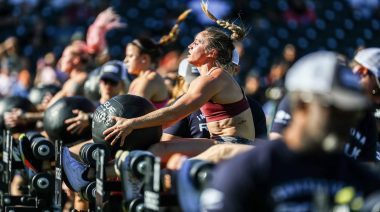“I hate competing. It gets in the way of my training.”
For a long time, I thought she was being funny or ironic when she said this. For me, the whole point of training is to compete. I’m one of those people who will not train if I don’t have some big, scary goal out in front of me to shoot for.
“I hate competing. It gets in the way of my training.”
For a long time, I thought she was being funny or ironic when she said this. For me, the whole point of training is to compete. I’m one of those people who will not train if I don’t have some big, scary goal out in front of me to shoot for.
If I could race every day, I thought, I would do it in a heartbeat! Where else can you get that high, drink in that atmosphere, and revel in that camaraderie? But as with many things, time has made me see the wisdom of her words.
It has become very popular to talk about falling in love with the process, rather than your goals. In our efforts to understand the roots and nature of human motivation, we each believe we can tell the world what has worked for us, and if they’d only try it, it would work for them, too.
But as I have matured as an athlete, I have found that you will love what you understand. For many, goals are that thing. They are clear, quantifiable, and easily explainable.
The process is much more nuanced, and there are many parts of it that are frankly unlovable. 5am workouts are hideous. 12-mile training runs are disgusting. High volume thrusters have a face that only a mother could love.
Granted, they are noble, necessary parts of many training plans, and they gain a certain beauty when looked at from afar. But in the moment, when your mind is compromised by the intensity of the effort, and your body is screaming bloody murder, there’s a good chance you’re going to hate them with every fiber of your being. And that’s okay. The good news is that you don’t really have to enjoy it in the moment, for it to work.
All of training is an assembly of tools that are carefully designed to get you from where you are to where you want to be. This is the difference between working out and training; the latter has an end point which shapes its every aspect. That end point may be competition, or a certain level of strength, or a change in body composition.
A Personal Definition of CrossFit
Regardless of whether you are in love with your goals or your process, it is clear that the two must match. And if CrossFit is part of your process, you must learn to implement it properly to get where you’re trying to go.
CrossFit, because of the breadth and variety of movements and protocols it can entail, can be a very different tool for many different types of athletes. It is becoming more commonly understood that CrossFit as a sport is far different than CrossFit as a training modality, and this is a good thing.
As a coach, I am happy to tell everyone I know that CrossFit is for them, but I must quickly follow that with the caveat that CrossFit is nothing like what you see on TV.
But negative definitions aren’t very helpful, so what is CrossFit? Sure, I know the definition that Greg Glassman came up with that’s printed on t-shirts and gym walls all over the world, but what is it really? The answer, as with most things in life, is “it depends.”
If all of training is an assembly of tools, CrossFit is perhaps the most versatile tool available. That whole “specialize in not specializing” thing is pretty useful, provided you have a coach who understands how to use it.
Glassman sort of cheated, when he created CrossFit. He stepped into an argument about what kinds of training protocols were the most productive for athletes, and simply answered, “all of them.”
I’m not here to tell you that just doing CrossFit’s “dot com” programming will make you great at whatever else you want to do. Anybody who’s watched some of the running at the CrossFit Games can tell you that only doing CrossFit makes you good at, well, CrossFit.
But the correct implementation of CrossFit protocols and programming can certainly help you get to wherever you’re trying to go. You just have to learn to use the tool correctly, and that starts with recognizing what CrossFit is to you, personally.
Define CrossFit Through Your Purpose
Creating your own clear purpose for your training is the first step toward getting the most out of it, and this applies to CrossFit as much as anything else. CrossFit provides a special challenge, in that there are so many areas where your purpose must be applied.
Once defined, it will act as a guide that will shape everything you do, from the movements you select, to the weights you choose, to how far into the pain cave you allow yourself to go on any given day.
Pulse Beat Fit’s own Dan Kallen, a former box owner himself, will tell you that there is no such thing as CrossFit programming, and he isn’t wrong. CrossFit programming is not unlike theology; put 20 people in a room with a single piece of spiritual text, and you are likely to get 20 different versions of what that text means.
Just as attempts at religious orthodoxy result in vigorous disagreement (and not a few wars), trying to interpret Glassman’s prescription into a more tangible definition of CrossFit programming as a single, cohesive concept results only in confusion and argument.
Glassman intentionally left his prescription open to wide differences in interpretation. This means that there are three “points of contact” to consider when we define CrossFit for ourselves:
- How the box owner interprets CrossFit into their programming, which will include their vision for the athletes in their gym, their own preferences and strengths as a coach, and the limitations of their facility, space, climate, and available equipment.
- How the athlete will perform the box’s programming, to include when and how to scale, what weights to select, when and how often to hit the gym.
- How each of these choices will affect the athlete’s progress toward their goals inside and outside the gym.
With those concepts in mind, let’s explore the most common types of athletes in any CrossFit gym, and how their purpose defines CrossFit for them.
The Total Novice
CrossFit continues to attract newcomers in droves, and that means a big percentage of the population at most boxes have been doing it for less than six months. Your purpose as a CrossFit newbie is probably loosely defined, but will include things like losing fat, getting stronger, learning to use your body, and having more energy.
But I’m here to tell you that your real purpose during this time is to stay healthy.
You’re going to stay healthy by scaling the daylights out of just about everything. There’s a good chance you are working harder physically than you have in a long, long time, maybe ever.
If you are hobbling out of the gym every time you come in, you’re probably not going to be back for three or four days, and that’s not doing you much good. So learn to scale aggressively, to conform your level of effort to where you are physically, and to meet the intent of what’s written on the whiteboard.
To make sure you’re doing that, ask your coach a zillion questions before the workout starts, until you are crystal clear that what you’re about to do matches both the coach’s intent, and your purpose for being in the gym.
The first six months or so of your CrossFit career should be the most fun you’ll ever have in the gym, if you’re smart about it. The gains come quickly, you’re learning a dozen new things every day, and there’s so much progress coming at you so fast, it about makes you dizzy.
When you start to feel like you know what you’re doing, it’s time to stay humble, not get aggressive. Keep molding your efforts and your scaling options to stay healthy, within the intent of the programming, and within your purpose.
The Nine-to-Fiver
This is the journeyman CrossFitter, who has been going for a year or so. They’re in the gym 4-5 times a week, cramming in WODs between work and the kids’ soccer practice and the grocery store. They may not have performance goals outside the gym, and may not have reevaluated their goals inside it since they first started.
Most coaches will tell you that the most dangerous person in their gym is the intermediate athlete. They’ve been around long enough to have some proficiency with most movements, they have a sense of their own strength, and so they’ve stopped asking questions.
There’s also a good chance they’ve lost sight of their purpose, or their purpose has started to evolve, so they’re just “doing stuff.” That stuff might include trying to Rx a workout they should’ve scaled, or loading about 20lbs too much on a bar during strength work, or mindlessly muscling through technique work instead of focusing on the cues the coach is giving the class.
It is perhaps more crucial for this type of athlete than any other to evaluate their implementation of CrossFit against their purpose. An injury from a lapse in judgment or stalled progress from a lack of intention in the gym knocks many an athlete off the wagon in this phase.
As with any effort toward improvement, consistency is the only thing that matters, and jeopardizing it with poor decisions in the gym will prevent you from getting to the next level.
Which is why it’s important for our intermediate CrossFitter to sit down and hammer out those goals again.
- Are you still 20lbs away from your body composition goal, but getting complacent?
- Are you paying as much attention to your nutrition and sleep quality as you are to your workouts?
- Are you finishing six minutes after everybody else, every day, because you wanted to move an Rx barbell?
- Now that you’ve come this far, how have your goals changed?
Once you’ve had this heart-to-heart with yourself, take a hard look at what you’re doing in the gym, and make sure your purpose and your process match.
The External Athlete
An athlete who chooses to use CrossFit as an accessory to training for another sport has perhaps the most complicated task of any category discussed here.
CrossFit for its own sake can be constantly varied, but if you’re trying to qualify for Boston, or Kona, or the American Open, the training for your primary sport will have a whole lot of structure. That may rub up against (or outright clash with) your time in the box.
A laser focus on purpose becomes critical for the external athlete. There simply isn’t a lot of slack in your training regimen for mistakes or lousy workouts, so the time you spend in the gym must add value to your overall plan. How do you make that work, when the workouts on the whiteboard aren’t written specifically to integrate into your training plan?
Take some tips from the newbie. Scale aggressively and intelligently, with your overall training plan in mind. If you know you have a stack of 200m sprints on the menu tonight, a workout with a hundred box jumps in it isn’t your best choice in the morning. Do step ups instead. If you just crushed yourself with hill work yesterday, don’t expect to access full power on your back squats today.
Never sacrifice the intent of the training for your primary sport to go HAM on your accessory training, just because it’s CrossFit. In other words, stop trying to win the WOD. That’s solid advice for the novice and the nine-to-fiver as well, but it’s even more important for you.
If you can’t reach the desired intensity or duration called for in your training plan because you wanted to PR your Karen time yesterday, then you aren’t adding value to your training with CrossFit, you’re watering it down. Train so you can train tomorrow, and rest when you have programmed rest days, rather than because you smoked yourself and can’t walk up the stairs in your house to go to bed.
Define and maintain your intention every time you set foot in the gym, and use that as the guideline to your effort in the workout. Be diligent about your accessory and auxiliary work, and find a coach who is happy to work with you to make the most of your limited availability. In the offseason, go nuts!
But once you enter a serious training phase, keep your CrossFit work in its place: second to your sport.
The Competitive CrossFitter
When CrossFit changes from training modality to competitive sport, a lot of the rules we discussed for the other categories go out the window.
Rather than looking to scale, you’ll be checking in with your body to see if there’s any reason you shouldn’t go Rx. Or Rx+. While you still need to keep your aggression in check most days in the gym, you’ll definitely be aiming to win some WODs.
When you don’t, pay attention, because those are the workouts that will highlight your shortcomings. Figure out where you’re consistently getting beat, and then get after it. It could be a movement, or a certain workout duration, or even your ability to transition quickly.
The hard part will be making yourself do the extra, unsexy work required to close those gaps. Nobody likes goat work, especially those who are used to dominating in the gym. But to be successful in any competition, you have to train your weaknesses, and compete to your strengths.
Speaking of winning WODs, if you find yourself winning all of them, it may be time to find a new gym. Don’t sabotage your progress by becoming the biggest fish in a very small pond.
It’s next to impossible to find the level of intensity required to become competitive even at a local level, when you’re lapping the field day in and day out in the gym. The best athletes in the world get there and stay there in the company of athletes at (or just over) their own level.
You won’t find Matthew Centrowitz out clubbing baby seals at a local charity 5k this Saturday, and neither should you waste your training time showing up the soccer moms at the 10am class.
One concept that is lost on many competitive CrossFitters is the idea of choosing your peaks. If your goal is to qualify for Regionals, signing up for every local throwdown isn’t going to help you get there.
Choose competitions that make sense with the timing of your overall season, which by necessity must peak during the Open. And as with choosing your gym, make sure you are entering competitions where you’ll be pushed, rather than ones you are guaranteed to dominate.
Don’t get distracted from your purpose in the gym. The volume and intensity of the work that’s ahead of you will take a lot of focus and a whole lot of grueling work.
Stay on the plan that you and your coaches have developed, rather than chasing the latest novel protocol you saw on YouTube, or throwing in an extra hero workout because it sounded cool.
Look to PR your nutrition and recovery as much as your muscle ups and snatches, because all that work won’t do you a bit of good if you aren’t giving your body what it needs to rebuild.
Make CrossFit Yours
The key to success in any relationship is open, honest communication. Whatever category of athlete you find yourself in, your success in CrossFit hinges on your ability to communicate with your coaches.
If they don’t understand your purpose, they can’t help you get to your goals as effectively. Tell them where you’re trying to go, and ask them for specific strategies that will help you get there. Ask for their help staying on track with the plan, and update them when your goals change.
Used with intelligence, CrossFit can provide unique value to any athlete’s overall training plan. But to be a constructive part of your process, you have to make sure that what you’re doing in the box aligns with your purpose.
Don’t ruin your training with excess competition by trying to win the daily WOD. Train so you can train tomorrow, and if your end goal includes competition of any sort, keep that intention at the front of your mind every time you set foot in the box.






